|
.JPG)
On this page we'll answer these questions
about extracorporeal shockwave
therapy in general:
What is
Extracorporeal Shock Wave Therapy (ESWT)?
What is Shockwave Biosurgery?
What is the origin of ESWT?
What conditions can you treat with
ESWT?
When is ESWT considered as a
treatment for these sorts of conditions?
When can't you use ESWT?
How effective is ESWT?
How fast does ESWT work?
How
safe is ESWT?
How does ESWT work?
How do the physics of ESWT promote
tissue healing?
We'll
also discuss some of the differences
between the various forms of
shockwave therapy on the market
today:
Are there different forms of ESWT?
What's the difference between the
different forms of ESWT?
Which is the best version of
shockwave therapy?
What form of shockwave therapy do
you use?
How do I know which version of
ESWT is being offered at a facility?
Where can I find the best, most
up-to-date form of ESWT available?
-------------------------------------
What is Extracorporeal
Shock Wave Therapy?
Extracorporeal
Shock
Wave
Therapy, (or
ESWT), is a new technology using shockwaves to treat
chronic, painful conditions of the musculoskeletal system.
A shockwave is an intense, but very
short energy wave traveling faster
than the speed of sound. The
word "Extra-corporeal" means "outside the body" and refers to
the fact that the shockwaves are generated outside the body.
What is Shockwave Biosurgery?
Extracorporeal shockwave therapy
(ESWT) is sometimes alternatively known as
shockwave biosurgery, though ESWT
isn't surgery as the word is usually
defined or understood in North
America.
|
What is the origin of ESWT?
The basic science behind ESWT is analogous to
lithotripsy, the technology that uses acoustic shockwaves to break up kidney stones without surgery.
The technique of using shockwaves to break up kidney stones has been around
for a nearly a quarter century now, and in the process of treating thousands
and thousands of patients, it was found that many
people undergoing the procedure had other unrelated aches and pains
disappear. It was at this point that scientists began to consider that
shockwaves may have an effect to heal other sorts of tissues.
Specialized machines were then
developed specifically with the idea of using these shockwaves on other
parts of the body, and this is the origin of ESWT.
The type of
shockwave therapy we use, then, is specialized to specifically help
treat musculoskeletal conditions.
What conditions
can you treat with ESWT?
|
|
|
|
The Piezoson 100
Extracorporeal Shock Wave Therapy (ESWT) Unit |
|
|
|
Extracorporeal
Shock Wave Therapy can be used to treat a wide variety of
musculoskeletal conditions--particularly those involving where
major connective tissues attach to bone.
Complaints
involving attachment points for tendons and
ligaments in major
joints like the shoulder (such as the rotator cuff),
elbow (epicondylitis or tennis elbow), hip, and knee (tendinitis
or "jumper's knee) are common sites for ESWT.
One of
the areas most frequently treated with ESWT, however, is the
foot. This is our specialty. Some
conditions in the foot that have been treated with
ESWT include:
|
Plantar Fasciitis
or Fasciosis (Strained Arch)
Achilles Tendinitis
or Tendinosis
Calcific Tendinitis or Tendinosis
Connective Tissue Pain and degeneration
Muscle Pain and Injuries
Joint Injuries
Morton's Neuromas
|
And as ESWT
encourages bone healing, it has been used to help treat:
Stress
Fractures
Avascular
Necrosis (A dead portion of bone)
Slow-healing bone (Delayed
unions)
Non-healing bone (Non-unions)
|
There are also
urological conditions that respond to ESWT, such as
Peyronie's Disease.
|
|
Research
presented at the 2005 International Conference on
ESWT in Vienna and the 2006 International Conference
in Rio de Janeiro demonstrated that ESWT is also being
studied for use for a wide variety of other
conditions as disparate as skin ulcers and other
chronic dermatological lesions, infections, angina,
arthritis, reflex sympathetic dystrophy (RSD), and certain
neurological conditions.
When is ESWT considered as a treatment for these sorts of conditions?
Shock Wave Therapy is generally considered when the following criteria are met:
-
When patient has a diagnosis that is
considered to be responsive to ESWT.
-
When simpler and less expensive treatment alternatives have failed or aren't
appropriate for some reason.
-
When surgery or other more invasive treatments are alternatives.
-
When the patient fully understands the procedure.
-
When there are no known contraindications to the procedure.
When can't you use ESWT?
ESWT is not typically used in
the presence of bone tumours, certain metabolic bone conditions,
and certain nerve or circulation disorders.
ESWT isn't typically used in pregnant patients and locations of an open growth plate, (where the bone
is still growing). It's not currently used in areas where an infection
is present, (though there is some early research suggesting ESWT may
actually help with infection). It also shouldn't be used in conditions
or locations where gas or air is present in the body, (rare in the locations
where ESWT is typically used)--or for other conditions as determined by your
doctor.
How effective is Focused
ESWT?
The answer to this
question depends upon which study you read, what methods were used in the
study, how "success" is measured in the study, the patients selected to be
included in the study, the condition being treated, and the machine being
used.
While there are some
studies (usually quoted by an insurance
company trying to find a way to justify not paying for ESWT
treatment) that suggest that shockwave hasn't been proven to
be effective, the vast majority of recent studies suggest that shockwave is
highly effective. For example, over 70 studies
were presented at the 2006 international shockwave seminar
in Brazil, and over 80 were presented the year before
in Vienna--and this doesn't even include the numerous
published findings in the medical literature.
Assuming you
have an injury appropriate to extra-corporeal shockwave technology treatment,
most recent independent studies suggest somewhere between a 65% and a 95%
"success" range, with values around 80% being the most commonly cited number.
And it's important to note that most of these studies have success rates
as determined by the patient, himself, in terms of pain and
function.
We find
that our results with the highly accurate piezoelectric
technology, are at least this successful.
The most important factor in getting a
good result with ESWT appears to be in selecting appropriate patients most
likely to benefit from this technology.
However, we
can't predict which patients will respond successfully to
ESWT and which ones won't.
How fast does
ESWT work?
We find that many patients get an
initial degree of improvement
almost immediately following treatment. This effect is usually
(but not always) temporary, and is associated with an anesthesia effect from the
hyperstimulation of the tissue from the ESWT.
It takes several days
for injuries to begin to heal, and many patients see an improvement before
the end of the second week. Depending upon your diagnosis, the healing
process may take several weeks or even months to be completed, but pain
relief often precedes the completion of the healing process.
How safe is ESWT?
The basic technology involved with
extracorporeal shockwave technology has been used for decades now on quite literally millions of people. The technology has
been used most extensively in Europe, particularly the German-speaking
countries, where this technology originates. In
all its use, ESWT of the musculoskeletal system has been found to have
virtually no serious side-effects. In fact, even mild side effects
like tingling, aching, redness, or bruising are relatively rare, modest and
short-lived.
Further, effects like
these appear to be more
common with higher energy treatments, particularly those from earlier generations of ESWT
technology than that
which we use. We'll discuss more about the different ESWT technologies
below.
How does
ESWT work?
Simply put, extracorporeal shockwaves stimulate
certain components within the body so the body is able to heal. And
ESWT is able to accomplish this even in chronic cases, when the body has
demonstrated a previous unwillingness or inability to do so by itself.
In addition to stimulating the healing process, ESWT seems to have a direct
effect on nerves, diminishing pain.
Many traditional
therapies--such as anti-inflammatory medications, steroid
injections, physiotherapy, massage, acupuncture, and so forth--can assist
the body during the early, acute phase of an injury. However, they are
much less effective in assisting the body to heal when an injury becomes
chronic. As an example, many patients can relate to a history where a
steroid injection (like cortisone) seemed to be effective in resolving pain
early in their healing process, but subsequent injections were much less
effective. This isn't really surprising when you realize that a
chronic-state, degenerative injury isn't likely to respond well to a medication designed
to affect an acute-phase, inflammatory condition.
What makes ESWT unique
is that it is one of the very few technologies in any field of medicine that
seems to work best when an injury reaches the chronic, non-healing state.
ESWT appears to be able to jump start the healing process in chronic,
non-healing injuries and move them back into the acute phase of healing.
How do the
physics of ESWT promote tissue healing?
While investigations
are still being conducted to more fully understand the precise mechanism
behind ESWT's effects on injured tissues, the picture is becoming much
clearer.
|
True ESWT produces a very strong energy pulse (5-100 MPa) for a very short length
of time, (approximately 10 milliseconds).
The energy pulse quite
literally breaks the sound barrier, and this is what creates the shockwave. |
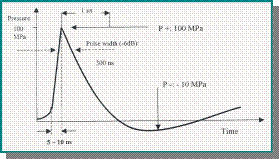 |
|
To the
right is a photograph of a plane flying faster than the speed of
sound and creating shockwaves. Shockwaves produced by an
extracorporeal shockwave machine are identical, only on a
smaller scale.
One
difference with the
shockwaves our machine is able to produce is that the shockwave
is generated, controlled, and focused precisely.
|
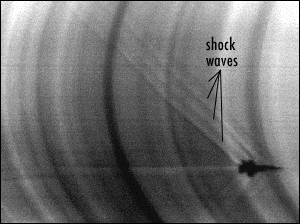 |
|
|
In
fact, the machine we use allows us to be able to control and
focus the shockwaves to such an extent we are able to pass the
shockwaves through the uninjured portions of the body without
any effect, and deliver the energy to a focus point at the level
of the injured tissue, where it has
several known medicinal effects:
-
First,
this shockwave exerts a mechanical pressure and tension
force on the afflicted tissue. This has been shown to create
an increase in cell membrane permeability, thereby
increasing microscopic circulation
(right) to the tissues
and the metabolism within
the treated tissues, both
of which promote healing and subsequent dissolution of
pathological calcific deposits.
|
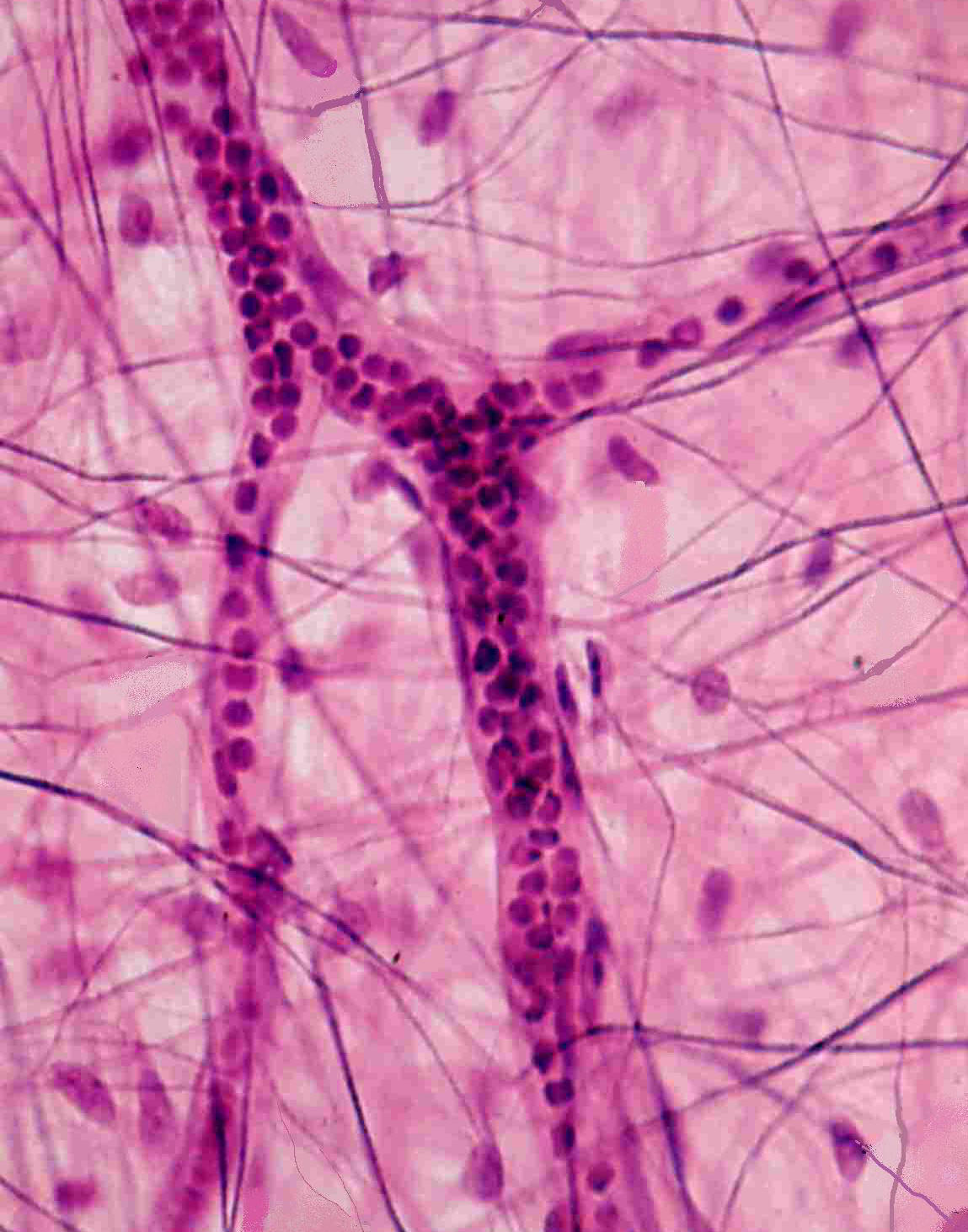 |
-
Second, the ESWT
shock waves pressure front creates behind it what are known as "cavitation
bubbles".
An example of a
single cavitation bubble is pictured to the right.
Cavitation bubbles are simply small empty cavities created
behind an energy front. They tend to expand to a to a
maximum size, then collapse, much like a bubble popping.
As
these bubbles burst, a resultant force is created. In the
human body, this force is strong enough to help
break down pathological
deposits of calcification in soft tissues.
|
 |
-
Third, as cavitation
bubbles collapse, they
create smaller, secondary energy waves known as microjets.
You can see how a microjet forms in the diagram to the
right, and you can see it pictured in the center of the
cavitation bubble in the photograph immediately above.
These microjets also create a lot of force that also breaks down pathological deposits of calcification in the soft
tissues through direct,
mechanical means.
|
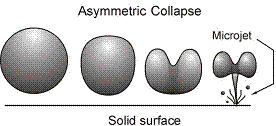 |
In the
application of an ESWT treatment in a medical setting, however, it's
not just one cavitation bubble or just a few cavitation bubbles
being produced, but hundreds and thousands.
To the right you can see what hundreds of cavitation bubbles formed from
a single shockwave looks like.
Multiply this by several
thousand shockwaves being administered to an injured tissue through a
course of ESWT treatment and you can imagine the forces that can be mustered to break down
deposits of calcification that are found in joints, soft tissues and
spurs.
|
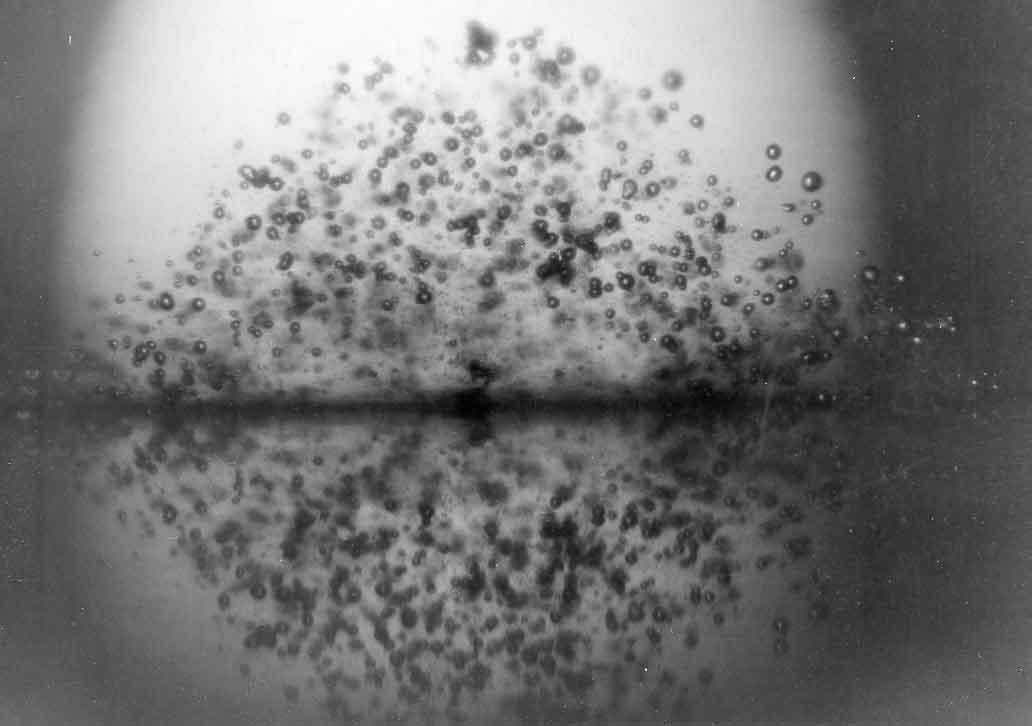 |
-
Beyond breaking down pathological calcification deposits, ESWT has been
shown to stimulate
cells in the body known as osteoblasts. These bone cells,
(pictured to the right), are responsible for
bone healing and
new bone production,
so stimulating them obviously enhances the healing process of bone.
|
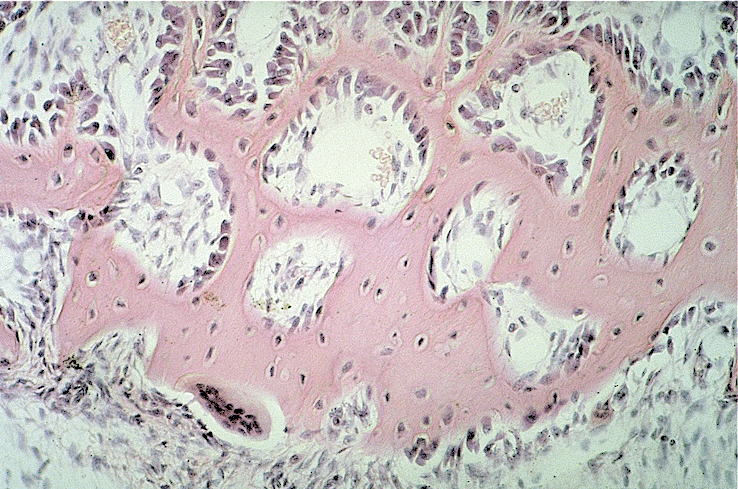 |
-
ESWT shockwaves
have also been shown to stimulate
fibroblasts, (pictured to the right). Fibroblasts are the cells
responsible for the healing of
connective tissues such as tendon,
ligaments, and fasica.
|
 |
-
ESWT also diminishes pain.
It does so in two ways. First, as mentioned above, ESWT
initially
diminishes pain through what is known as hyperstimulation anesthesia.
This is where the nerves sending signals of pain to the brain are
stimulated so much that their activity diminishes, thereby decreasing or
eliminating pain. This effect is usually, (but not always), short lived.
-
ESWT is also
believed to diminish pain over
longer periods of time through the stimulation of what is known as the "gate-control" mechanism, where nerves can be
stimulated to "close the gate" to pain impulses sent to the brain.
It is sometimes thought of as activating a sort of "reset" button that
recalibrates pain perception.
Interestingly, and in apparent
support of this theory, it was demonstrated by research presented at the 2005
conference in Vienna that using anesthesia
with ESWT alters the sensor input - motor output balance of nerve fibres,
inhibiting the pain-killing effect of ESWT.
In other words, ESWT
appears to be most helpful for patients who are not anesthetized.
(This explains why some some early studies where anesthesia was used
before the administration of extracorporeal shockwave therapy did not get results as good as what is found in
patients where no anesthesia is used.)
As
the piezoelectric version of shockwave we use does not require
anesthesia, this serves as one explanation as to why piezoelectric shockwave works so
well.
While ESWT is used on a
wide variety of body tissues and medical conditions (see the
What conditions can you treat with ESWT?
section above), the effects of shockwaves
are best documented in areas of changes in tissue density, such as where
tendon attaches to bone (enthesiopathies) and where bone attaches to ligaments
(desmopathies). For this
reason, it is very effective for painful connective tissue pain in such
locations as the foot,
knee, hip, elbow, and shoulder.
Are there different forms of shockwave therapy?
While there are
numerous shockwave machines on the market today, they are all based on one
of four basic
shockwave (or shockwave-like) technologies. Listed in the order in which
they were introduced in Canada, they are:
-
Electrohydraulic
shockwave (such as the HMT OssaTron machine)
-
Electromagnetic
shockwave (such as the Sonocur and Dornier Epos machine)
-
Radial pressure
wave (such as the
Dolorclast system)
-
Piezoelectric
shockwave (such
as the machine we use, the Piezoson by Wolf).
What's the difference between these forms of shockwave therapy?
Electrohydraulic,
electromagnetic, and piezoelectric technologies are all true forms of
extra-corporeal shockwave therapy. Each technology produces a pulse
that literally breaks the speed of sound, thereby creating a shockwave.
These technologies differ in the
manner in which the shockwaves are produced, the ability of the shockwave to be
controlled and focused, the depth to which the shockwaves can penetrate, the intensity of
the shockwave being produced, the sorts
of conditions they're able to treat, and whether they require anesthesia.
The third technology on
the list above, radial therapy, is actually quite different from the other
three technologies in several regards and is usually not considered true extracorporeal shockwave therapy--but more of
a pressure wave therapy.
We'll try to
differentiate all this for you. First let's go through the three true
forms of ESWT--electrohydraulic, electromagnetic, and piezoelectric.
Manner of Generation and Delivery of Shockwaves
-
Electrohydraulic
shockwave therapy uses a type of spark plug
to generate a shockwave, with the shockwaves focused by an ellipsoid
reflector.
-
Electromagnetic shockwave therapy machines
typically use a cylindrical coil
arrangement of an electromagnetic generator and a parabolic
reflector to focus the shockwaves.
-
The piezoelectric shockwave is
generated by an electric pulse, and the shockwave focused by
thousands of small crystals in the applicator head.
Each of
these three technologies is similar in that the shockwaves and force
produced in the machines is translated past the skin and superficial
tissues without effect, and are instead focused
at the desired tissue depth.
The fourth
technology, Radial
shockwave (RSWT) or more accurately, pressure wave therapy, differs from the other forms of shockwave technology
in a couple major regards. First, in order for
a shockwave to truly be defined as
a shockwave, the energy wave must literally be faster than the speed
of sound, or 1500 meters per second. This is the speed at
which the "shock" of the shockwave is generated, from breaking the
sound barrier.
In comparison,
RSWT waves travel at speeds of approximately 10 meters per second, a
small fraction of true shockwave. This speed does not break
the sound barrier, and hence, no actual shockwave is produced.
Indeed, the
very wave form produced by radial technology differs from true shockwave
rather noticeably.
True focused shockwaves are very short and very intense; radial
pressure waves are slower, less intense, elongated, and more
sinusoidal in
appearance.
Because no
actual shockwave is produced with RSWT, and because the waveform is
so different, you can better see why RSWT is not considered a
shockwave technology. It is more accurately described as a
pressure wave technology, and most researchers now use this term to describe this technology. However,
some facilities with these machines continue to inaccurately label
their technology as shockwave therapy.
Tissue Depth
Penetration:
As you might
imagine intuitively, being able to aim shockwaves directly on the desired
tissues and only the desired tissues is generally considered to be
superior to not being able to direct the shockwaves to the specific
injured tissues.
Electrohydraulic, electromagnetic, and
piezoelectric shockwave can all be aimed and delivered past the skin and
down to different tissue
depths, allowing for delivery of the therapeutic waves to the injured
tissue.
Radial pressure
waves are applied to the skin
only, and must dissipate to the tissues from there.
They are therefore not able to be
aimed to different tissue depths. Deeper tissue injuries are therefore more difficult to treat with radial
shockwave.
Focus Area:
|
A third
characteristic to consider is how precisely the energy waves are
able to be focused onto the injured tissue and away from uninjured
tissues.
The tighter the focus area, the more precisely the shockwaves can be
delivered to specific tissues, and the less energy is wasted in areas not
requiring treatment.
|
|
Not only does this mean a
greater concentration of therapeutic energy on the specific injured
tissues, it also means less trauma to the surrounding uninjured tissues.
As alluded to
above, the piezoelectric technology
we use has,
by far,
the tightest focus area of any competing technology in the world.
For instance, even at maximum energy
level, the focus area for the Piezoson 100, (the machine we use), is
1.3mm x 1.3mm x 4.2mm. (This equates roughly to 1/20th of an inch
x 1/20th of an inch x 1/6th of an inch.)
In comparison with other machines in North
America, the focus area for the Ossatron is 8.7mm x 8.7mm x 67.6mm; the focus area for the Sonocur is
4.8mm 4.8mm x 48.3mm and for the Epos it's 2.9mm x 2.9mm x 22.0mm.
(Radial pressure waves cannot be focused at all.)
(Source for these
statistics, the German site on physical parameters of extracorporeal
shock wave therapy technologies:
http://stosswellentherapie.org/fach/vergl.html)
As these statistics
make clear, the piezoelectric
technology is the most accurate ESWT technology on the market.
Treatment is more precisely directed at injured tissues and the least traumatic to uninjured tissues surrounding the site
being treated.
However, because
piezoelectric technology is so precise, it needs to be applied carefully
and precisely to the correct tissues. This is why we don't hire ESWT technicians to
perform the therapy. We only have doctors applying the treatment.
This is actually the law in many jurisdictions in Europe, but the
exception in North America, where technicians perform most ESWT
treatments in the vast majority of facilities.
Energy Level:
Another important differentiating
characteristic is how high an energy output
the machine produces. In fact, this characteristic is commonly used in
marketing various machines.
For instance, you'll see many
websites touting the benefits of their machine being either "high
energy" or "low energy". Facilities with "high energy" machines
claim, for example, that their technology is superior because only one
treatment is typically required and the technology has been around
longer. Facilities with "low energy" machines advertise that it
doesn't require anesthesia and it's cheaper.
While there is some
truth to each of these claims, the larger question is frequently not mentioned.
That is to say, the question that should be asked is what is better at actually treating a
particular condition? High energy or low
energy?
Before we can
answer this question, you
should know that the energy level of a machine is actually a fairly
complicated subject and it deserves some discussion.
For instance, you'd
think that the energy produced by a machine would be a pretty clear-cut
characteristic. But there are several different--and confusing--ways
to measure energy. For example, you could consider the amount or
type of energy
produced by the machine, the amount or type of energy delivered into
the body, the amount or type of energy delivered into the focus area, the amount or type of energy delivered to
a central
point inside the focus area, or the amount or type of energy present at
a certain radius from that central focus point.
Each of these
characteristics is important to the scientists studying various
characteristics of ESWT machines, and different manufacturers and
scientists use different definitions of "energy".
As you might
expect, so many variables
make it rather confusing to both patients and physicians. After
all, even doctors aren't sure what type of energy is most important when judging
which technology is a better in which to invest.
For
the purposes of this discussion, we'll concentrate on the most common
standardized measurement of energy in the field, something called the
"energy flux density", expressed in millijoules per millimeter (mJ/mm2)..
Energy flux density can be defined as the
amount or concentration of energy in the focus area. In other
words, this is the amount of therapeutic energy being delivered to the
injured tissue. The physics of the other measures of energy are
interesting, but we feel this is the characteristic in which most
patients and physicians are interested.
Now even when we've
defined what we mean by an energy level and defined the unit of
measurement, you should know that different
authors use different cut-off measurements to define "high energy" and
"low energy". One author's "high energy" setting may
only qualify as a "low energy" setting in another author's opinion.
So the terms "high energy" and "low energy" are rather imprecise and
arbitrary. (This demonstrates why the marketing of "high energy"
and "low energy" machines is somewhat dubious.)
For the purposes of
this discussion,
we'll define low energy here as less than 0.27 mJ/mm2
, medium energy as 0.27 mJ/mm2
to 0.59 mJ/mm2
, and high energy as anything over 0.60 mJ/mm2.
These are frequently-used cut-off points, but do keep in mind that other practitioners, researchers, manufacturers,
and websites may use different values.
So now that we've
defined what energy is, what's considered high, medium, or low energy, let's get
back to the question of what energy settings are better to treat a
specific injury.
The answer that
seems to becoming more clear in research is that
both high energy settings and low energy settings have their
indications.
For instance, certain tissues (like bone)
appear to
respond better to higher energy settings. Conditions like
avascular necrosis and delayed unions and pathological calcifications are examples of
conditions that are typically thought of as being more responsive to
higher intensity settings. In addition, the original medical
application for shockwaves, the treatment of kidney stones, too, seem to
be most effective with higher energy settings.
However, other tissues (like
tendons and other more sensitive structures) typically require lower energy settings, as
research indicates that these they may be damaged
by higher-intensity settings.
Complicating
matters further, what does a patient do when both
hard and soft tissues need to be treated for a single injury, as is
often the case? For example, what
if a patient has both a bone spur and a soft tissue injury
like fasciitis or tendonitis? Is it better to go with a so-called
"high energy" machine or a "low energy" machine?
The good news is
that it doesn't have to be an either-or proposition. The beauty of
the piezoelectric ESWT
technology we use is that it covers the energy spectra employed by the
other
technologies.
For instance, piezoelectric ESWT can be applied in energy levels
as low as .05 mJ/mm2--obviously
well into the lowest levels of energy--and it can be raised as high as 1.48
mJ/mm2--an
energy level well above even the classic "high energy" machines.
In other words, in
terms of the amount of energy applied in the focus area, (the so-called
"energy flux density"), piezoelectric technology can be delivered in
energy doses as low as virtually any other competing technology and as
high or higher than virtually any other technology.
Further,
piezoelectric technology can be readily adjusted to any energy level,
depending upon the specific condition and indication of each individual
case. And as mentioned above, the energy can be precisely focused
to the specific depth required.
Our patients don't
have to compromise for a single energy range or a specific tissue type.
And because the
machine we use is so precise, we can use high energy settings in areas
very close to the most sensitive tissue structures. This allows
the piezoelectric technology noticeable advantages to machines with much
less precise focus areas.
Anesthesia Requirements:
The energy the machine
produces also affects the need for anesthesia (whether local, general, or
spinal) or IV sedation. All
things being equal, it's
obviously preferable for
the patient not to have to go
through anesthesia or sedation. It's not only safer, it's also less
expensive.
Beyond the issues
of safety and expense, though, there is mounting evidence that the use
of anesthesia diminishes the effectiveness of ESWT. Specifically,
the use of anesthesia with ESWT alters the sensory input - motor
output balance of nerve fibres, which seems to be why anesthesia diminishes the pain killing effect of ESWT.
So unlike other
so-called "high-energy" machines, the piezoelectric technology does not typically
require anesthesia--even at high energy settings. And further,
this means it's more likely to work than versions requiring anesthesia.
Which is the best version of
shockwave therapy?
There is a natural tendency
for practitioners to feel some bias towards the form of
technology which they use personally.
However, we can tell you
that when
Shockwave Therapy - BC
was formed, all these different technologies were available
to us,
and we had the opportunity to examine each of them.
We've even examined and investigated many
machines not available in North America.
|
|
After all
our investigations into each form of shockwave technology and each
generation of machine, it became apparent to us that the
piezoelectric form of ESWT technology
in the form of the Piezoson 100 offers distinct advantages in comparison
with any other ESWT technology. So we believe
that this form of shockwave therapy is the best version available anywhere.
For example, the
technology we use is the only form of ESWT that combines each of
these important features:
|
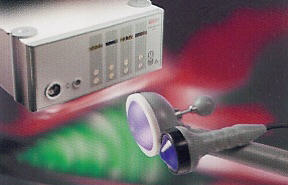
|
|
Below:
Applicator pads for ESWT handpieces
 |
1.
Piezoelectric shockwave therapy is the
newest, most up-to-date
form of ESWT available
anywhere.
Simply put, piezoelectric technology is
state-of-the-art.
|
 |
2.
Piezoelectric shockwave
therapy
employs multiple applicator heads (left), which enable
the therapeutic shockwaves to be
directed to the desired tissue depth.
The
energy from this machine is able to literally passes
through the body's undamaged tissues (like, say,
skin and muscle) without effect, then the energy
wave is precisely focused and concentrated on the
desired tissue depth.
|
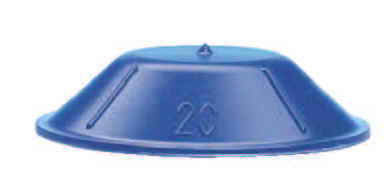 |
3. Of
all ESWT technologies that can focus their energy
waves, piezoelectric shockwave therapy has, by far, the smallest
focus area, meaning it is able to be
focused the most precisely
compared with competing technologies. This allows
for greater precision in delivering the therapeutic
energy to the desired tissues, as well as less trauma to
the surrounding tissues, than any other technology on
the market anywhere in the world.
|
 |
4. Piezoelectric shockwaves are
adjustable in
strength.
We can adjust the strength of the energy wave in the
focus area, the so-called "energy flux density", very
precisely to any desired therapeutic level, whether in
the "low energy" region or "high energy" region.
|
 |
5.
Unlike other high-energy
machines, the Piezoson 100 technology
does not require
hospitalization, anesthesia or IV sedation.
This is means added safety and less cost for the
patient, and better results, as using anesthesia with
ESWT appears to diminish the pain-killing effects of
ESWT.
|
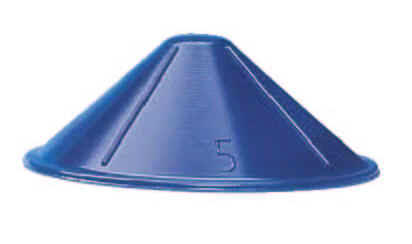 |
6. The Piezoelectric version of ESWT technology is
an
extremely cost effective technology for the patient
compared with other technologies. In fact,
patients have found the price difference so profound
that we've had patients from over 1/2 of the Canadian
provinces and U.S. states--not to mention countries as
far away as Asia, Africa, and South America.
|
|
Piezoelectric
technology offers the best features available in
extra-corporeal shockwave therapy. For these reasons,
we believe that the piezoelectric form of ESWT is the best technology available anywhere.
Until recently, this
piezoelectric shockwave technology had been only available in Europe.
So when it recently became approved for use in Canada, we were quick to
choose this technology. We are pleased to say that our facility was the first
facility using this newest form of ESWT technology in Canada.
And to the best of our knowledge, we are still the only facility
using this technology in all of western Canada.
This newest form of ESWT technology is
still unavailable in the United States--though the other, older forms of
ESWT do exist in the United States.
|
Below:
Various handpieces for different ESWT
applications
|
|
|
What form of shockwave therapy do
you use?
We use the newest-generation, and we
believe the best standard of
shockwave technology available anywhere, the piezoelectric
standard.
Specifically, we use the Piezoson 100
machine by the Richard Wolf Company in Germany, which covers
both the high-energy and low-energy spectrum.
|
|
|
How
do I know which version of shockwave therapy is being offered at a facility?
Many facilities don't
go into much detail about the different versions of ESWT technology.
Perhaps they may feel it doesn't matter to the patient or that
the information is too technical for most patients. But if you're
having significant pain and are searching for answers, if you're curious
which machine may be most applicable to your condition, we feel this is the
sort of information that we find a lot of patients seek. If the
facility you're considering isn't clear about what version of ESWT
technology they're using and you wish to know, you should ask.
Where can I get the best, most
up-to-date
form of focused ESWT?
At present, the only
site we know of in British Columbia or in Western Canada offering Piezoson
100 ESWT is at our facility in Surrey, British Columbia near Vancouver. While
this technology has been around for many years in Europe and in Canada for
nearly two years, it is not yet
available in the United States or in many other countries around the world.
For this reason,
we welcome patients from any area who are seeking this newest of
ESWT technology. Overnight or longer stays can be arranged at some of
the recommended
hotels near our facility.
We can be contacted at:
|
Shockwave Therapy - BC
Suite 102
10190 - 152A Street
Surrey, British Columbia
V3R 1J7 Canada
T: 604-589-5234

|
|
For more maps and
directions to our location, please follow the following
link.
___________________
Website Directory
What
We Offer
General Information About ESWT
How We're Different
Information About Your Visit
About Us
About Dr. Schumacher
Answers To Financial Questions
Location, Directions and Maps
Hotels Near Our Facility
Traveler's Information
Links
Contact
Us
Return
Home
___________________
|
|